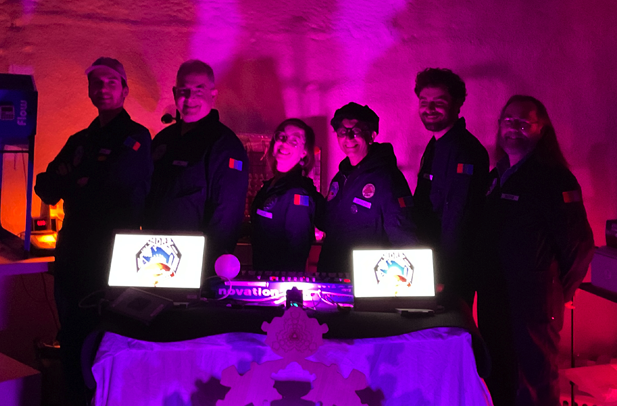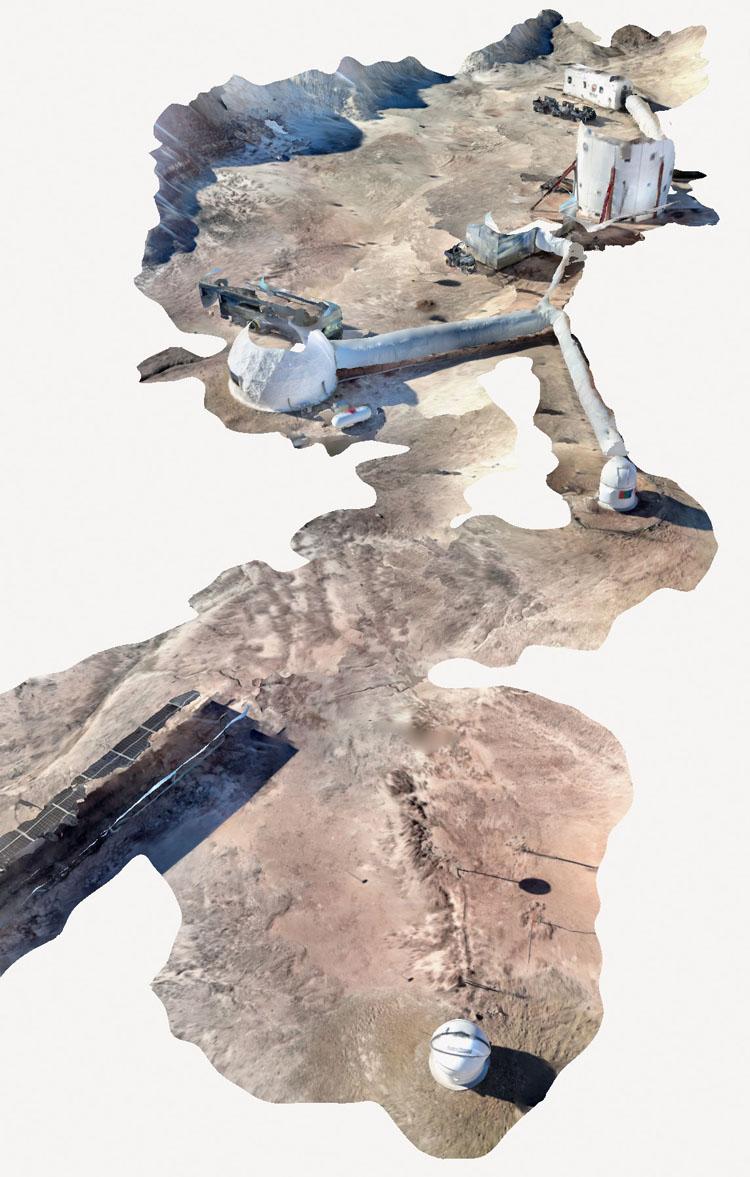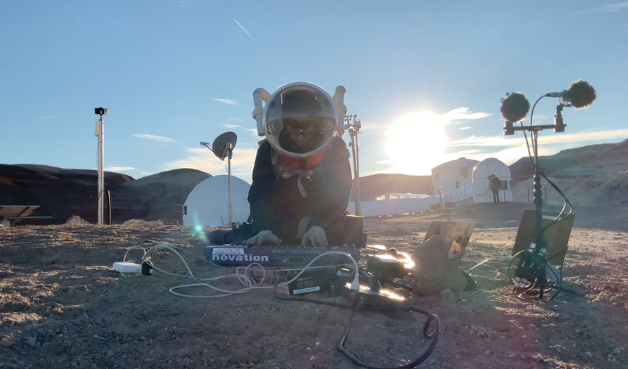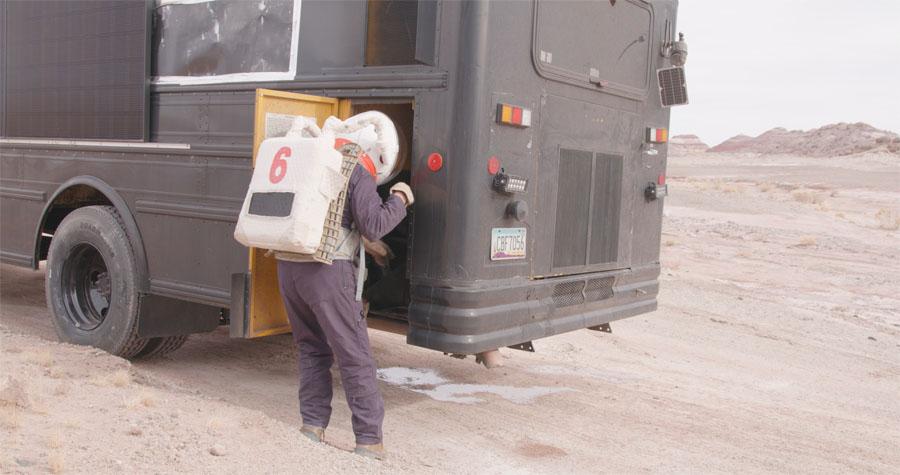FINAL REPORT – MDRS 286
Nov 12–24, 2023
Roger Gilbertson – Commander
Donald Jacques – XO, Engineer
Liz Cole – HSO, Journalist
Guillaume Gégo – Scientist
Scott Beibin – Artist
Hugo Saugier – Documentary

Our diverse, creative and dedicated crew carried out a broad range of science, technology, and art projects including:
• Bacterial growth experiment helpful for creating closed-loop life support systems
• An extended range EVA using the MASH (Mobile Analog Space Habitat) vehicle
• Technology demonstrations collecting and studying some in situ resources
• LiDAR scanning of campus structures and local geological features
• Simulation and comparison of music as it would sound on Mars and Earth
• Metal casting and component fabrication
• Extensive videography of all aspects of habitat and EVA operations
• Daily media updates
• Daily monitoring of the environmental and life systems aboard the MASH
• Hosted two NY Times photojournalists for four nights who remained fully “in sim” with us
PROJECT 1: CO2 Fixation by Purple Bacteria for Space Food Production – Gégo
Purple bacteria Rhodospirillum rubrum were grown inside low-cost bag photobioreactors to assess the possibility of mass-production in altered gravity. This can provide CO2 absorption and production of important nutritional supplements for humans on Earth and Mars.

OD measurements between SOL 3 and 5. Growth is visible and follows known trends. Similar experiments will be performed at the University of Mons to confirm these results.
After nine days of steady growth it reached a stationary phase, indicating they had reached their peak. Samples were collected regularly, and are being returned to Belgium for analysis.
PROJECT 2: Performing Extended Extra-Vehicular Activities Using a Mobile Analog Space Habitat – Jacques
MASH EVA 11 excursion on Sol 11 lasted three-hours. We drove the vehicle south to Kissing Camel Ridge and parked. Liz and Guilliame exited and walked acquired drone footage of interesting cliff formations. Hugo and Don recorded the MASH at rest and driving.
An unexpected engine warning light led to a spacesuited excursion to successfully service the engine, while remaining fully in-sim.
PROJECT 3: Creating High Resolution Interactive Digital Assets of MDRS and Local Geological Sites Using 3D Scanning techniques – Beibin
I conducted four successful LiDAR scanning EVAs on geological features and MDRS campus buildings. With each excursion, various technical and procedural problems were identified, and solutions were implemented. This gave increasingly improved results with each EVA.

PROJECT 4: Producing Functional Artifacts Using Local Clay Resources and a 3D Extrusion Printer – Beibin
On EVA 4 we gathered clay near the Science Dome, but given time constraints and limited water resources, no further processing of the clay was performed. The samples will be taken to my lab in Philadelphia to process and create test 3D extrusions.
PROJECT 5: Using Local Gypsum Resources to Produce Molds for Metal Casting — Gilbertson
Since learning that previous missions had processed local gypsum into plaster, I used commercially prepared material in order to focus on casting. One mold pair produced four castings (one had structural problems and was melted and recast). The final pieces were trimmed and assembled into a tensegrity icosahedron using six elastic bands to suspended them without touching.

Left: Final cast parts and bands. Right: Assembled tensegrity icosahedron.
PROJECT 6: Mars Academy – A Documentary Film About ESA Scientist Claude Chipaux and the Past, Present and Future of Mars Life Sciences – Saugier
Filming an analog reality is quite a challenge when you’re making a documentary, but from the number of situations it generated on a daily basis, from EVAs to group discussions, brainstorming sessions and so on, I can say I’m bringing back some interesting footage in my suitcase. The other crew members were really available and willing to participate in the project, always keeping an eye on what they could bring to the table, which was really appreciated as a filmmaker. Even though I was busy almost every day, I also tried to help the others as much as I could.
As for the more technical aspects, I found it hard to handle all the shots by myself, but with good quality equipment and a few points learned in the field, it became somehow doable. The hardest things were the sound and shooting in the sun with the reflections from the helmet (but I found the suit in itself wasn’t that big of a deal). However, I always prefer challenge to comfort, so I was very excited to look for tricks to adapt my camera rig to the conditions. Being totally immersed in a mission, in addition to being a great human adventure, was the right approach, in my opinion, to get the most relevant footage of an MDRS analog mission.
Beyond these personal considerations, and as the grandson of one of the founders of the MELiSSA project, I was particularly fascinated by the works of Guillaume Gégo and Donald Jacques on life support systems. The way they think about how to supply not only space expeditions, but also multiple potential locations on Earth, has something that makes you dream of beautiful future explorations on the one hand, and stay connected to our immediate and urgent realities on the other. Not only did I find their works very relevant, despite their very different schools and ways of thinking, but they are exactly the kind of people I needed in the project to make a narrative connection between my grandfather’s story and analog missions.
Thanks to this stay here at MDRS, I’m happy to say that I somehow lived my grandfather’s dream: to experience Martian life, even if it was simulated, because I think that setting the context is enough to give you the first hint of what some real Martian sensations could be.
PROJECT 7: Simulating Acoustics of Mars for an Outdoor Martian Music Performance – Beibin
Using data published in Nature [https://www.nature.com/articles/s41586-022-04679-0] and from NASA [https://mars.nasa.gov/mars2020/participate/sounds] I collaborated with audio engineer John Knott to create a digital audio filter that accurately simulates how sound travels on Mars.
I conducted three Ptelepathetique performance. The first at night inside the Science Dome. Then a “sunrise” set north of the Observatory Dome, and then a “sunset” show east of the dome.
Each presented a musical audio comparison demonstrating the differences between sounds we would hear on Earth versus on Mars with its thinner, colder atmosphere.

Scott performs as listeners at the dome enclosure enjoy audio as we might hear it on Mars.
PROJECT 8: Documenting the MDRS Mission 286 Adventure in Words and Images – Cole
I recorded interviews with Guillaume and Scott regarding their experiments and creations. We arranged for two live conversations, one with Mars Society Belgium, then one with Journal des Enfants a children’s publication to inspire future astronauts and scientists. The MS Belgium event led to an interview with science publication Athena.
We provided visiting NY Times photojournalists with captions for their images, and very much enjoyed their five day / four night visit.
PROJECT 9: Evaluating Performance of Biological Life Support Components Installed within the Mobile Analog Space Habitat – Jacques
Upon arrival and docking at MDRS, the MASH mini-farm was populated by by two (2) operating PhotoBioreactors with Spirulina culture; approximately 55 blue tilapia, twelve (12) quail, 100 meal worms, 100 red wiggler worms, a garden, and marsh. By the end of the first week, I noted challenges in that I had added too many quail at once, and the consequences were the loss of 65 tilapia, and an overabundance of guano and odors. Despite this, each of the components functioned as designed, even though overloaded. I have much to correct as I look forward to growing the system, and improving its functionality and resilience.

Don services the MASH vehicle while remaining fully in-sim.
CONCLUSION
We enjoyed a challenging, diverse, multifaceted, and ultimately extremely memorable, rewarding and enriching experience at MDRS. On to Mars!









You must be logged in to post a comment.